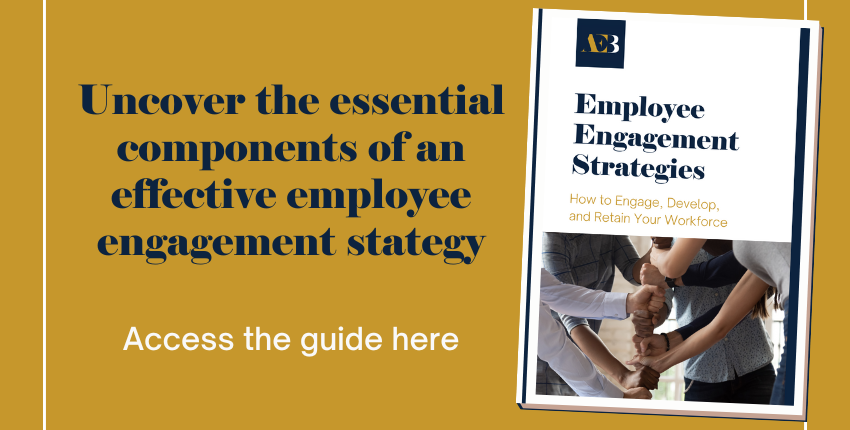There are two critical aspects to managing seismic and fundamental change: understanding the situation (what is happening and why) and then developing a plan to adapt. The labor market has seen substantial change in a very short period — instigated by the pandemic and fueled by individuals defining what is important to them. Now it’s up to organizations to adapt, and one means to do that is by creating a career path for your employees.
Once upon a time, employees would join organizations and work there for nearly their entire careers. They became part of a business’s growth and development. Over the years and decades, that level of commitment (on both sides of the relationship) changed to something much more transactional. Perhaps the biggest shift has been in the roles of this partnership. Now, employers become part of an employee’s personal growth and development.
In short, employees have taken ownership of their career progression. However, employers still have a vital role to play by supporting their employees with a clear career path.
Keep reading to learn what your employees want in a defined career path, what benefits this can provide your organization, and the steps to creating this for your employees.
What Your Employees Want in a Career Path
In a prior blog article, we shared that one of the factors in employee turnover is when employees lose sight of the strategic direction of your company. Part of them understanding your corporate vision is the ability to see themselves in your future plans. Employees want to know they have a future with you and more importantly, how their careers can grow with you.
Unfortunately, the reverse of being able to see and be an integral part of your organization’s future has a very real and detrimental effect. Employees who feel that their skills are not being put to good use in their current job are ten times more likely to be looking for a new position. (LinkedIn)
Yet, more than an ability to envision the future, employees want a sense of purpose in their careers. People need to know that what they are doing matters. How does their role support the services you provide? Where are they providing value for colleagues and customers? Employees who don’t feel like their efforts matter or have opportunities for learning and personal growth will quickly become disengaged.
Here’s one more interesting thing that your employees want. For as much as they are looking to you for guidance in where their careers can go within your organization and the needed support to get there, they don’t expect you to create these opportunities alone. Eighty-one percent of respondents in a survey to understand career progression shared that professional development was a shared responsibility between employees and management. (Quantum Workplace) Your employees want to be involved in creating a career path.
Employees want to know:
-
How their personal goals and career progression fits within your organization.
-
Where their strengths can be used to support business growth.
-
What their purpose is within your organization.
-
How you will provide guidance and support to advance their careers.
-
That they have an active voice in planning their career development.
A well-defined career path helps employees progress from where they are to where they want to be. Done well, this path may allow them to accomplish that within your organization rather than piecing together a career progression plan with various roles and companies.
The Benefits of Creating a Career Path for Your Organization
Though, longevity isn’t the only benefit career mapping has for your organization. Creating a career path for each role you have (and hope to create) has value for every aspect of your workforce. Consider these benefits within the broader areas of recruitment, performance management, and retention.
Recruitment
Job candidates have become increasingly selective in who they will even consider for future career opportunities. They have a myriad of choices now which only increases the complexity of their decision process. Learning what their career opportunities are during your recruitment and evaluation stages will improve the attractiveness of your organization to potential employees.
Even more, when you have a detailed career map for your organization, it will help you identify areas where you need more talent and aid in prioritizing what positions you should be hiring for first. While remaining in a hiring mode is advantageous, knowing how you need to hire and when is the best position to be in.
Performance management
Defining a career path for your employees will drive employee performance and development. Here’s how.
First, career mapping aids in your onboarding process by providing direction for new hires. Outlining the framework for how your organization is structured and how the various roles are connected with help speed the transition of new employees from external candidates to impactful employees because they will have a clear understanding of what is expected of them.
Second, detailed career paths provide structure for employee performance. We’ll explain how to create a career path in a moment, but defining the required skills and benchmarks for each role also defines how work performance will be measured and evaluated. It can be challenging for employees to know what they are working towards when they are unclear about benchmark standards.
Third, defining the career progression for your employees removes blocks in career growth like plateaus or stagnation. A career plateau occurs when employees have nowhere else to advance to. This means they have two choices: remain (which usually leads to declines in morale and work performance) or advance their career elsewhere.
That decline in work performance due to disengagement and lack of forward career momentum is called career stagnation. This situation may be even more detrimental to your organization because it signifies an employee that is merely going through the motions of their position without care or purpose.
The fourth benefit related to performance management is the creation of equity in employee advancement. Your employees not only want to know their purpose and how their careers will progress in your organization, but also that promotions and advancements are awarded fairly and without prejudice. Clear requirements for each role provide leadership with clear standards to measure against and define what employees are working towards.
Employee retention
Companies that excel in internal mobility retain employees for an average of 5.4 years. In companies that struggle in this area, the average retention span is nearly half that at 2.9 years. (LinkedIn) Creating a career path for your employees will enhance your employee retention rates. Providing career development opportunities will help employees achieve their personal goals. Further, it helps you build an organization of increasingly skilled employees eager to advance their careers with you over your competition or another field entirely.
There’s one more benefit for you that a career path will provide: a detailed succession plan for every role within your organization. Historically, succession planning was reserved for business owners and select c-suite executives and only because a situation and need arose. However, progressive organizations are realizing that preparing every employee for their next role provides greater competencies across all areas of your business and smooth transitions when someone does leave. Career paths allow organizations to be proactive instead of hastily reactive to vacancies, regardless of the reason.
How to Create an Organizational Career Path
With the desires of your employees and benefits for you outlined, there are three phases to developing an effective organizational career path for your business: create, communicate, and confirm.
Phase 1: Create
The first phase will be the most exhaustive and time-consuming but it is important to get right for the process to provide the most value for your organization. Step one is to refine your organizational chart. This means considering the roles you currently have, the positions you will or hope to have in the relatively near future, and the connections between them. Bear in mind, that this is the minimum baseline for your organizational career path.
Next, define each role going beyond just a title or area of accountability. Detail what is required for each position in terms of baseline skills and knowledge, scope of responsibility, and key performance indicators (KPIs). Your goal is to show and explain how employees can progress and advance within your organization.
Phase 2: Communicate
Successful organizations communicate effectively and transparently with their employees. Share your career path, explain and promote the opportunities, and celebrate each advancement members of your organization are making. Current and future employees are asking for you to provide this for them, make sure you are then capitalizing on this investment in your futures.
This phase should never really be considered completed though. You will need to provide ongoing opportunities for learning and career development as new technology and processes are introduced into your industry. Also, ensure that your managers and leadership team are fully trained and informed on how to support and coach their respective team members.
Phase 3: Confirm
With any initiative your organization introduces, it is important to measure and track your results. Here you will want to capture the level of engagement with your learning opportunities and progress levels of employee development. How many employees are participating in various training programs? How many employees are being promoted within your organization and how frequently? Where are more resources needed?
Regularly review the mobility and progression of your employees for areas to improve or new avenues to create. Make sure your career path grows with your business so that career progression is accurate and reflective of your organization.
Career Mapping Dos and Don’ts
What the career path looks like for your organization may be very different from your closest competitor and perhaps even more so for related businesses within your industry. There is no right or wrong to what your career path will look like because your business is as unique as your team of employees. However, here are best practice tips and summaries to keep in mind.
-
Develop a robust plan that is more than an organizational chart. Define qualifications, skills, and responsibilities for each position role. This will also serve as performance standards and a way to clarify expectations.
-
Don’t create a career path as a stand-alone document or activity. Your process needs to be aligned with current and future positions within your company, required competencies and capabilities, and organizational growth.
-
Create or provide development opportunities to help employees advance. Beyond competitive compensation and flexibility this is what current and future employees are now expecting from you.
-
Incorporate career path discussions into performance reviews and normal ongoing meetings with employees to encourage and support employees. This means ensuring you have both managed and self-directed development opportunities available and are regularly reviewing them to confirm they are up to date.
-
Regularly review your defined career paths to verify requirements and standards remain valid. They should expand as your organization grows.
-
Openly communicate your career path so that everyone understands and is aware of their career progression opportunities. According to a 2021 survey conducted by Gartner, only thirty-three percent of candidates who searched for a new position in the past twelve months looked within their organization first. Share and encourage employees to work towards their next levels. Celebrate growth and advancement.
-
Don’t limit your options. For smaller organizations that may not yet have multiple layers and roles, consider ways to enlarge or enrich the positions you do have. Enlargement means expanding the scope of a role with added tasks or related projects. Enrichment is increasing the depth of the role with increased responsibility and/or decreased oversight. Every organization, regardless of size, can provide career growth opportunities.
-
Accept that not all employees will want to advance in their careers in the same way. Allow space for someone to excel in their role without pressure to pursue roles with increased responsibilities and demands. Enlarging and enriching roles are applicable here too and may offer a more desirable career path for some individuals.
-
Allow for interdepartmental change/growth beyond just vertical advancement. Look for and create paths that accommodate for lateral progression, especially where capabilities intersect. Consider opportunities exist due to the development of new, but related skills, knowledge, and experience.
Beyond flexible work environments and competitive compensation, employees want their careers to be rewarding. More than that, they want to know where their current positions will lead and how they can advance within their current companies. View their requests as opportunities for your organization with attractive avenues for growth and advancement. In the end, that investment in learning will reward you with a highly skilled and knowledgeable workforce that desires to stay and grow with you.
For more information and strategies to engage, develop, and retain your workforce download our helpful resource guide. You can access this below.


.png)





